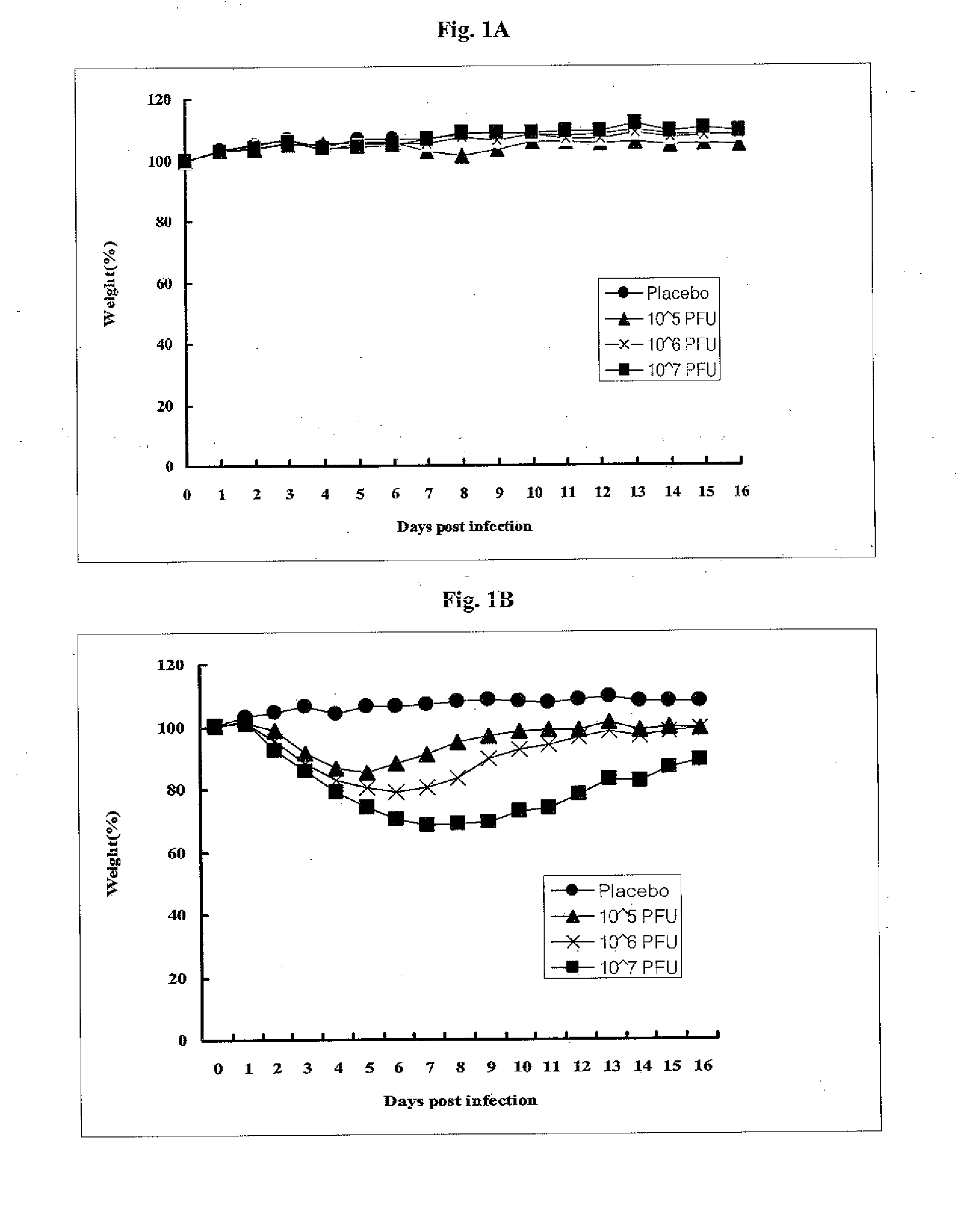Attenuated influenza virus and a live vaccine comprising the same
a technology of attenuated influenza virus and live vaccine, which is applied in the direction of viruses/bacteriophages, biocide, antibody medical ingredients, etc., can solve the problems of high morbidity and mortality among the entire population, antibodies to one subtype do not properly react, and young healthy peopl
- Summary
- Abstract
- Description
- Claims
- Application Information
AI Technical Summary
Benefits of technology
Problems solved by technology
Method used
Image
Examples
example 1
Cold-Adaptation of Influenza a Virus
[0088]The mother strain was subjected to repeated passage in embryonated chicken eggs at progressively lower temperatures to select virus with mutations that would produce a cold-adapted and temperature-sensitive phenotypes. Eggs were incubated at 30° C., 27° C. or 24° C. for 3-5 hours before virus inoculation and then incubated at the same temperature after inoculation. For each temperature, 5 or 6 embryonated eggs were injected via allantoic route. The inoculum (10041) contained 0.001 HAU to 0.1 HAU. Infected allantoic fluids were harvested after 72 or 96 hours and titrated by HA assay. Among these, the highest growth virus were selected and used for the next passage. Following the procedure, the mother strain was serially passaged 19 times in embryonated chicken eggs at 30° C. and then serially passaged additional 40 times at 27° C. Finally, this virus was further passaged 33 times in embryonated chicken eggs at 24° C. This cold-adapted virus w...
example 2
Growth Characterization of PT-IV-01 Cold-Adapted Influenza Virus in Embryonated Chicken Eggs
[0089]The growth characteristics of PT-IV-01 was examined and compared with the mother strain in embryonated chicken eggs. Embryonated eggs were inoculated with 0.1 RAU of PT-IV-01 or the mother strain and incubated at 37° C., 30° C. and 25° C. Allantoic fluid was harvested 3 days after inoculation and titrated with HA assay. As shown in Table 1, PT-IV-01 virus grew in eggs at 25° C., whereby the mother strain was not detected in HA assay. When growth pattern of the PT-IV-01 and the mother strain were compared at 37° C., the yield of the PT-IV-01 virus was significantly lower than the mother strain. As a result, the cold-passaged PT-IV-01 virus exhibited both cold-adapted phenotype and restricted growth phenotype at body temperature in embryonated chicken eggs. Overall, the growth profile is shifted in favor of low temperature thanks to repeated passage at low temperature. Notably, the virus ...
example 3
Growth Characterization of PT-IV-01 Cold-Adapted Influenza Virus in Animal Cell Line
[0090]The ca and ts properties of the PT-IV-01 virus were assessed by plaque assay on MDCK cell at both low and high temperatures. Plaque forming unit (PFU) were compared at three different temperatures, 25° C., 33° C. and 39° C. The plates of infected virus were incubated 5-7 days at 25° C. and 2-3 days at 33° C. and 39° C. Growth at 33° C. was used as the standard condition.
[0091]As shown in Table 2, the PT-IV-01 virus formed plaques efficiently at 25° C., but inefficiently at 39° C. The result showed that PT-W-01 virus had appropriate cold-adapted and temperature-sensitive properties in animal cell lines, extending similar observations in embryonated eggs. Clearly, the optimal temperature for plaque formation was shifted in favor of low temperature. It is worth noting that the virus titer of PT-IV-01 (8.1-8.6 log10 pfu / ml) is similar to that of the mother strain (8.4-8.5 log10 pfu / ml), suggesting ...
PUM
| Property | Measurement | Unit |
|---|---|---|
| temperature | aaaaa | aaaaa |
| temperature | aaaaa | aaaaa |
| temperature | aaaaa | aaaaa |
Abstract
Description
Claims
Application Information
 Login to View More
Login to View More - R&D Engineer
- R&D Manager
- IP Professional
- Industry Leading Data Capabilities
- Powerful AI technology
- Patent DNA Extraction
Browse by: Latest US Patents, China's latest patents, Technical Efficacy Thesaurus, Application Domain, Technology Topic, Popular Technical Reports.
© 2024 PatSnap. All rights reserved.Legal|Privacy policy|Modern Slavery Act Transparency Statement|Sitemap|About US| Contact US: help@patsnap.com










